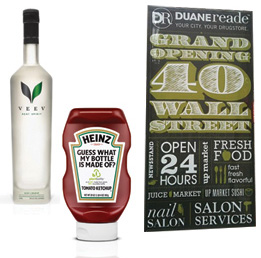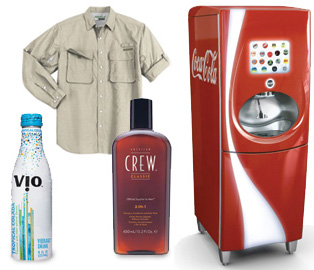 by Michelle Greenwald –
by Michelle Greenwald –
How exactly do we define innovation? While it’s probably the most overused term in business today, innovation is not a fad. It’s not even new. What differentiates a smart innovation—and makes it worth writing about—is that it has the capability of moving a business forward in ways that can result in more customers, more sales, more brand loyalty, more good will, or some combination of those effects. Smart innovation is capable of providing a company with competitive advantage. Innovations are smart when they are not just inventions for innovation’s sake, just to be new and different; rather they provide a strategic benefit.
Innovation has always been relevant because it aims to satisfy unmet consumer and business needs; as the new-product development time-to-market continues to shrink and product life cycles get shorter and shorter, the term will become even more relevant. What qualifies as an innovation, in my mind, is a product, service, aspect, or feature that is new, different, surprising, clever, fresh, attention-getting, challenging of conventional ways things are done, and is an obvious improvement on “what’s out there” in that particular product category and geographical area.
Got all that? Keep in mind, innovations don’t have to be complicated, or technically advanced—though surely they can be. What qualifies to me as an innovation can be as simple as putting a fourth ball in a tennis ball can (which had always just held three), thereby fulfilling the consumer need for more balls to play with and increasing each purchase by 33 percent. It can be as simple as turning a ketchup bottle upside down so consumers don’t have to wait for the ketchup to drip down in a partially empty bottle, so people use more ketchup as a result of bigger squirts each time, and so the face panel at the top of the package is wider, making it easier to communicate the brand message at the point of sale.
Innovation can also be as simple as bringing a product, ingredient, component or service that exists in one country to another country. Argon oil from Morocco has been a hit beauty aid and hair care ingredient in recent years. Açai from Brazil, an antioxidant powerhouse ingredient, has spawned a multitude of new food and beverage products, including the açai-fortified vodka Veev.
Having worked in the new products field for nearly 20 years, for companies such as Nestle, Pepsi-Cola, and Disney, I have long been fascinated by the thought processes that enable people to innovate: how can existing firms or entrepreneurs come up with breakthrough ideas, no one else has thought of, or how can “old things” be done better, more easily, faster, and less expensively.
Many consulting firms claim to uniquely possess the Holy Grail of methods to enable their clients to think more innovatively and create more successful new products and services. Over the years I have observed that there are many ways to successfully innovate, largely based on directing or channeling thought processes along focused lines to achieve a variety of different strategic goals. I call these directed thought processes “lines of innovation thinking.” Stated at the outset of a brainstorming session, these goals lead participants to brainstorm in along certain paths. I have identified approximately 40 different lines of innovation thinking. Each month I plan to highlight a different line of thinking and illustrate successful and interesting products and services that have resulted from it.
A currently highly popular line of thinking is convergence. Convergence entails merging a number of different products into one, thereby enabling that product to steal share and source users, not only from competitive products, but also from other categories of products, which might not even seem related. The ultimate convergence product in my mind is the Apple iPhone, in large part due to all the apps designed for it and technology embedded in it. The iPhone is a camera, an alarm clock, a note pad, a calculator, a map, a photo album, an e-reader, and the list is nearly infinite.
Other examples include: a television embedded in the door of a refrigerator (that could be great for someone who spends a lot of time in the kitchen), American Crew’s shampoo, conditioner, and body wash all-in-one product, and the ExOfficio insect-repellent infused clothing line, which can help protect against malaria. The ExOfficio label informs that the protective effect lasts through 70 washings. The innovative features of all three products can provide a competitive advantage, attract customers to that brand, and justify a price premium.
In the case of the ExOfficio shirt, insect-repellent companies could loose sales as a result. The fabric-infused repellent could represent a disruptive change to the bug-spray industry, if this value-added shirt becomes popular and the premium price is lessened to make it more of a mass-appeal item.
In the case of the American Crew all-in-one, if it performs all three functions well, it could cannibalize sales from each of the company’s own individual shampoo, conditioner, and body wash products. Firms need to calculate in advance if there is more to gain from providing a competitive point of difference (more functions for less money), versus potentially hurting one’s own brands from cannibalization. In general, smaller brands have less to loose by offering this type of potentially cannibalistic benefit, since there is so much share to be gained. For more established companies and brands, it’s often not a good bet. Firms also need to anticipate where trends are going. If the convergence trend continues, cannibalizing oneself might be seen as preferable to being cannibalized by others.

Often firms look at convergence as a way to expand a product line into peripheral and large markets. Three fairly simple examples in the non-alcoholic beverage industry are Minute Maid’s Ice Tea Lemonade, Vio carbonated flavored milk, and Coca-Cola’s new Freestyle vending machine, in which consumers can make their own hybrid beverages: up to 100 different combinations. All three are from the Coca-Cola Corporation. In the case of Minute Maid, the brand must have determined that there was much to be gained by sourcing sales from the large and more rapidly growing ready-to-drink iced tea market. And since consumers were already combining tea and lemonade, it made sense to create the product already mixed. In the case of Vio carbonated flavored milk, milk-product producing companies have long sought to add the fun of carbonation to their products as a way of increasing sales. Conversely, soda companies have long sought to add the health benefits and mother-approval benefits of milk to sodas. In the example of the new Freestyle vending machine, Coca-Cola is capitalizing on the trends of consumer generated products and individuality, by allowing customers to effectively customize their own beverages and have fun in the process.
Convergence is affecting nearly all industries, as firms try desperately to expand sales beyond their historical categories. Another great example is drug store retailing in New York City. Duane Reade, a leading chain, now has a physician on call and offers inoculations at some of its stores, putting them in competition with traditional physician’s offices. In some, they carry fresh produce, salads, and sandwiches, putting them in competition with small grocery and convenience stores. In the Wall Street location in New York City, Duane Reade even have a hair and nail salon, putting it in competition with beauty parlors.
The lesson from the convergence trend is that firms must defensively anticipate adjacent industries that might covet their space and enter their markets, while at the same time evaluating new categories to enter, where they can leverage their strengths and grow. Complacency is not a viable strategy.
HT: Inc.com (read full article)
